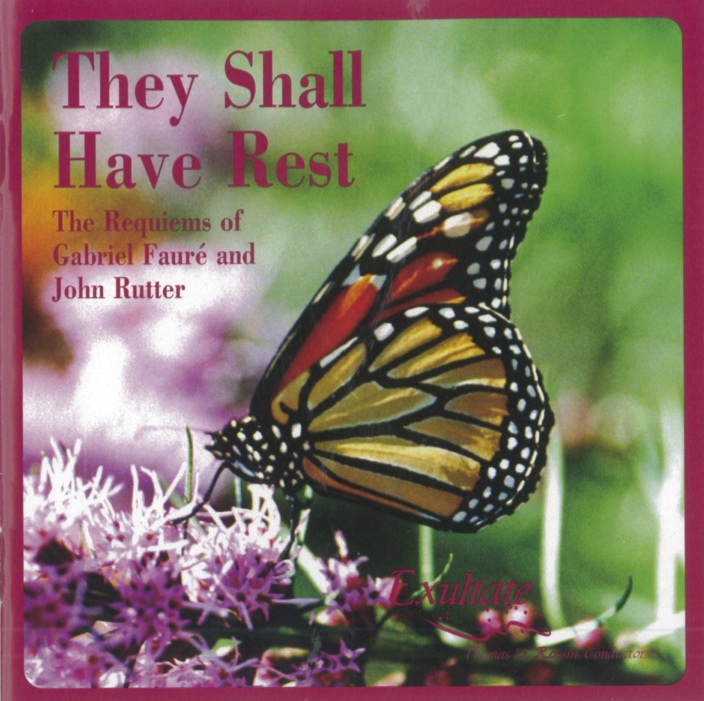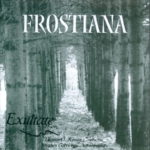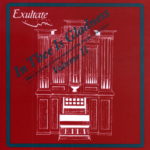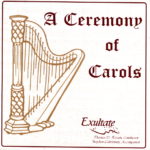They Shall Have Rest
$15.00
A reverie to rest and relax in a harmonious, heavenly peace.
Description
REQUIEM – Gabriel Fauré:
1. Introit and Gradual (chorus)
2. Offertoire (chorus & baritone)
3. Sanctus (chorus)
4. Pie Jesu (soprano)
5. Agnus Dei (chorus)
6. Libera Me (chorus & baritone)
7. In Paradisum (chorus)
REQUIEM – John Rutter:
1. Requiem Aeternam (chorus)
2. Out of the Deep (chorus)
3. Pie Jesu (chorus & soprano)
4. Sanctus (chorus)
5. Agnus Dei (chorus)
6. The Lord is My Shepherd (chorus
7. Lux Aeterna (chorus & soprano)
Other Works:
Sospiri (Opus 70) – Sir Edward Elgar
Requiem (Opus 48) – Gabriel Fauré
(soloists: Sarah Zimmerman, soprano; Bill Strom, baritone)
As organist and choirmaster at the Church of the Madeleine in Paris, Gabriel Fauré provided music for countless funeral masses for his parishioners. In January 1888, he chose to perform a five-movement Requiem he had composed himself for the funeral of M. Lesoufaché, a well-known architect. The clergy chastised Fauré for his musical novelty and unorthodox selection of texts from the traditional Requiem Mass, especially his unique decision to set the Pie Jesuprayer from the end of the Dies Irae as a separate, solo movement. Fauré, however, was quite pleased with his results. He composed two additional movements, the Offertoire andLibera Me, with baritone solos crafted for his friend, Louis Ballard, a singer from the Paris Opera. Over the next ten years he composed various orchestrations to suit both church and concert hall, considering the work to be equally at home in both liturgical and concert settings. Fauré later said of his Requiem that it is “dominated from beginning to end by a very human feeling of faith in eternal rest.” Rather than the vision of judgement and wrath common to earlier Requiem settings, Fauré preferred to focus his art on the promise of heaven, saying in a 1902 interview “…but it is thus that I see death: as a happy deliverance, an aspiration towards happiness above, rather than as a painful experience.” He also expressed surprise at the work’s instant popularity. Indeed, over a century after its publication in 1901, the Requiemremains the most performed and recorded of all Fauré’s works.
Requiem – John Rutter
(soloist: Sarah Zimmerman, soprano)
John Rutter was inspired to compose his Requiem by two events in his life: the death of his father in 1983 coupled with his opportunity soon thereafter to study the original manuscript of Fauré’s Requiem. Although his previous compositions had been almost exclusively by commission, he decided – much like Fauré – to compose the Requiem setting on his own terms. To honor his father’s memory he sought to create an accessible work which would take the listener on a journey from loss and darkness into joy and light. Rutter chose a symmetrical arch of seven movements to create his musical journey. The work begins and ends with the traditional first and last movements of the Latin requiem mass, Requiem Aeternam and Lux Aeterna. For the second and sixth movements he chose two psalms often associated with funeral services, setting each for choir in English with an instrumental solo. The setting of Psalm 130 adopts a blues style with the solo cello beginning on the lowest note the instrument can play, truly “out of the deep.” The parallel setting of Psalm 23, the most beloved of all the psalms, evokes peaceful images of the shepherd boy David with the oboe solo as the shepherd’s pipes. Rutter returns to Latin for the third and fifth movements, selecting two prayers to Christ. The Pie Jesu is a serene soprano solo in emulation of Fauré. The Agnus Deicombines the solemn image of Christ, the Lamb of God bearing the sins of the world, with texts from the Burial Service of the 1662 Book of Common Prayer. After the choir’s dramatic plea for mercy subsides, the flute enters with the ancient Gregorian sequence Victimae Paschali Laudes, telling the Easter story, and the choir sings the text Rutter calls the linchpin of the entire Requiem, “I am the Resurrection and the Life,” John 11:25. The journey out of darkness is complete at these words, and only light remains. At the center of the arch is theSanctus, a hymn of praise to God and a vision of the heaven to come. Rutter originally composed his Requiem for the modest forces of a small church choir and organ with solo instruments. He later expanded the orchestration for concert use. The work was instantly successful, with over five hundred performances in the first six months after publication. In his mixture of Latin texts and Gregorian chant with English texts and contemporary harmonies, Rutter has created a moving work of consolation and hope which transcends religious denomination.
Sospiri (Opus 70) – Sir Edward Elgar
Early in his career, Edward Elgar composed a work titled Salut d’Amour for violin and piano as an engagement present for his fiancé. The sentimental “greeting of love” became immensely popular and helped establish Elgar’s reputation as a composer. Some twenty-five years later he decided to compose a companion piece, Soupir d’Amour. During the months he worked on the composition, however, world events gave him a sense of foreboding and his “sigh of love” grew more bleak and dramatic. He changed the title to Sospiri, Italian for “sigh.” The first performance was given in London on August 15, 1914, shortly after the outbreak of the First World War.
Program Notes – Yvonne Grover
You must be logged in to post a review.
This site uses Akismet to reduce spam. Learn how your comment data is processed.






Reviews
There are no reviews yet.